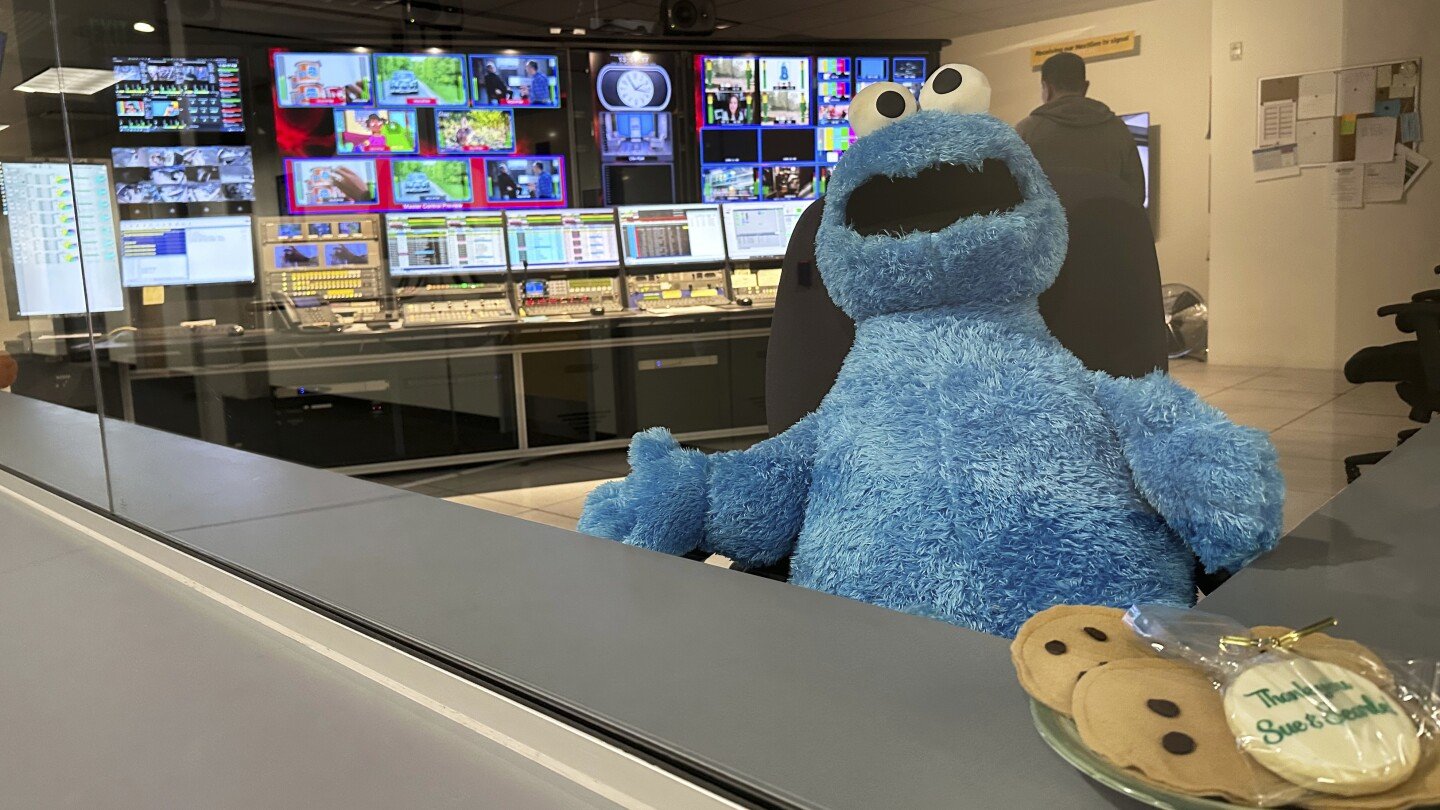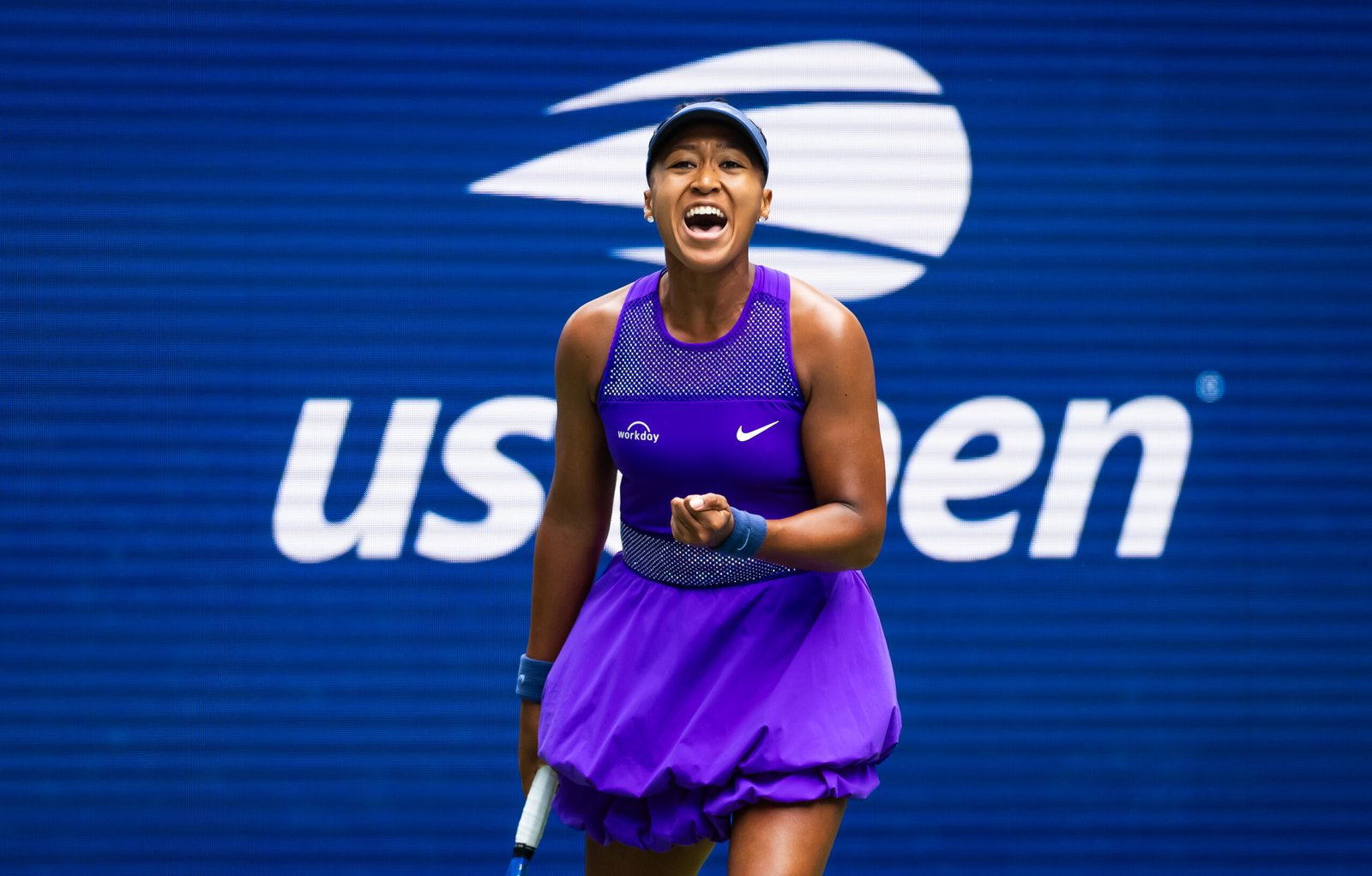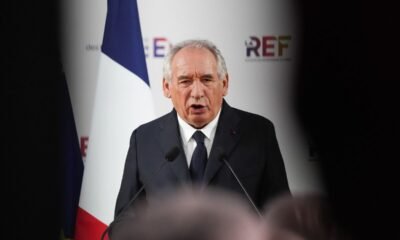Top Stories
Center for Public Broadcasting cuts hit a nonprofit that’s helped fund Sesame Street

The Corporation for Public Broadcasting, which helps pay for PBS, NPR, 1,500 local radio and television stations as well as programs like “Sesame Street” and “Finding Your Roots,” said Friday that it would close after the U.S. government withdrew funding.
The organization told employees that most staff positions will end with the fiscal year on Sept. 30. A small transition team will stay until January to finish any remaining work.
The private, nonprofit corporation was founded in 1968 shortly after Congress authorized its formation. It now ends nearly six decades of fueling the production of renowned educational programming, cultural content and emergency alerts about natural disasters.
Here’s what to know:
Losing funding
President Donald Trump signed a bill on July 24 canceling about $1.1 billion that had been approved for public broadcasting. The White House says the public media system is politically biased and an unnecessary expense, and conservatives have particularly directed their ire at NPR and PBS.
Lawmakers with large rural constituencies voiced concern about what the cuts could mean for some local public stations in their state. They warned some stations will have to close.
The Senate Appropriations Committee on Thursday reinforced the policy change by excluding funding for the corporation for the first time in more than 50 years as part of a broader spending bill.
How it began
Congress passed legislation creating the body in 1967, several years after then-Federal Communications Commission Chairman Newton Minow described commercial television a “vast wasteland” and called for programming in the public interest.
The corporation doesn’t produce programming and it doesn’t own, operate or control any public broadcasting stations. The corporation, PBS, NPR are independent of each other as are local public television and radio stations.
Rural stations hit hard
Roughly 70% of the corporation’s money went directly to 330 PBS and 246 NPR stations across the country. The cuts are expected to weigh most heavily on smaller public media outlets away from big cities, and it’s likely some won’t survive. NPR’s president estimated as many as 80 NPR stations may close in the next year.
Mississippi Public Broadcasting has already decided to eliminate a streaming channel that airs children’s programming like “Caillou” and “Daniel Tiger’s Neighborhood” 24 hours a day.
Maine’s public media system is looking at a hit of $2.5 million, or about 12% of its budget, for the next fiscal year. The state’s rural residents rely heavily on public media for weather updates and disaster alerts.
In Kodiak, Alaska, KMXT estimated the cuts would slice 22% from its budget. Public radio stations in the sprawling, heavily rural state often provide not just news but alerts about natural disasters like tsunamis, landslides and volcanic eruptions.
From Big Bird to war documentaries
The first episode of “Sesame Street” aired in 1969. Child viewers, adults and guest stars alike were instantly hooked. Over the decades, characters from Big Bird to Cookie Monster and Elmo have become household favorites
Entertainer Carol Burnett appeared on that inaugural episode. She told The Associated Press she was a big fan.
“I would have done anything they wanted me to do,” she said. “I loved being exposed to all that goodness and humor.”
Sesame Street said in May it would also get some help from a Netflix streaming deal.
Harvard professor Henry Louis Gates Jr. started “Finding Your Roots” in 2006 under the title “African American Lives.” He invited prominent Black celebrities and traced their family trees into slavery. When the paper trail ran out, they would use DNA to see which ethnic group they were from in Africa. Challenged by a viewer to open the show to non-Black celebrities, Gates agreed and the series was renamed “Faces of America,” which had to be changed again after the name was taken.
The show is PBS’s most-watched program on linear TV and the most-streamed non-drama program. Season 10 reached nearly 18 million people across linear and digital platforms and also received its first Emmy nomination.
Grant money from the nonprofit has also funded lesser-known food, history, music and other shows created by stations across the country.
Documentarian Ken Burns, celebrated for creating the documentaries “The Civil War,” “Baseball” and “The Vietnam War”, told PBS NewsHour said the corporation accounted for about 20% of his films’ budgets. He said he would make it up but projects receiving 50% to 75% of their funding from the organization won’t.
Influence of shows
Children’s programing in the 1960s was made up of shows like “Captain Kangaroo,” ’’Romper Room” and the violent skirmishes between “Tom & Jerry.” “Mr. Rogers’ Neighborhood” mostly taught social skills.
“Sesame Street” was designed by education professionals and child psychologists to help low-income and minority students aged 2-5 overcome some of the deficiencies they had when entering school. Social scientists had long noted white and higher income kids were often better prepared.
One of the most widely cited studies about the impact of “Sesame Street” compared households that got the show with those who didn’t. It found that the children exposed to “Sesame Street” were 14% more likely to be enrolled in the correct grade level for their age at middle and high school.
Over the years, “Finding Your Roots” showed Natalie Morales discovering she’s related to one of the legendary pirates of the Caribbean and former “Saturday Night Live” star Andy Samberg finding his biological grandmother and grandfather. It revealed that drag queen RuPaul and U.S. Sen. Cory Booker are cousins, as are actors Meryl Streep and Eva Longoria.
“The two subliminal messages of ’Finding Your Roots,’ which are needed more urgently today than ever, is that what has made America great is that we’re a nation of immigrants,” Gates told the AP. “And secondly, at the level of the genome, despite our apparent physical differences, we’re 99.99% the same.”
Top Stories
Osaka’s reset comes full circle with win over Gauff at the US Open

NEW YORK — This was a fourth-round match with unusually large consequences, a highly charged litmus test, a gut-check in real time.
After missing the entire 2023 season on maternity leave, four-time Grand Slam champion Naomi Osaka has expressed frustration with her lack of progress. When would her game regain that ethereal major-winning quality?
Coco Gauff, even in the wake of a title at Roland Garros, turned to biomechanics specialist Gavin MacMillan just before the US Open, willing to sacrifice short-term results by playing the long game. Could she rely on her great strengths of speed and competitive fire while making significant adjustments to her serve and forehand?
The answers arrived in only 64 minutes on Monday in Arthur Ashe Stadium as Osaka dropped a decisive 6-3, 6-1 decision on Gauff to advance to the quarterfinals. It’s Osaka’s first major quarterfinal since winning the 2021 Australian Open.
It was reminiscent of the memorable match between the two here six years ago. Osaka, at the height of her powers, dispatched a 15-year-old Gauff 6-3, 6-0 in a third-round match that ended with tears. The difference is that Gauff was seeded No. 3 here and Osaka was No. 23.
“I mean I’m a little sensitive — I don’t want to cry,” Osaka said afterward. “Honestly I had so much fun out here.
“This is my favorite court in the world, and it means so much to be back here.”
Much has been made of Osaka’s move to coach Tomasz Wiktorowski. And while Iga Swiatek’s former coach has been a boon to her confidence, the difference between the 2024 Osaka and this year’s edition might just be fitness — and the confidence that brings.
Even earlier this year, she appeared sluggish at times, impatient to end points quickly. Against Gauff, Osaka moved exceptionally well, weathered long rallies and stayed in a visibly positive frame of mind. Her intensity was palpable.
So was her patience. Osaka won 16 of the 24 rallies that went five shots or more. She also converted each of the four break points she earned. Osaka next plays Karolina Muchova, a three-set winner against Marta Kostyuk.
Gauff, meanwhile, consistently struggled with her forehand and service game. There were five double faults, but the forehand was the real issue. Gauff had 20 unforced errors on that side. On this occasion, even her usually reliable backhand sometimes broke down.
Even early on, Gauff’s forehand was fluky (five errors) and Osaka broke and then held at love for a 2-0 lead.
But while Gauff — with a tweaked toss — had eased into her service games in the opening rounds, she came out firing against Osaka. She stroked two aces in her second service game and the other two first serves were unreturned. They were all 110 mph-plus.
That break was the only margin until Gauff, trailing 5-3, was broken again. Two double faults, in addition to two groundstroke errors, gave Osaka the set in 31 minutes.
With the match on serve at 3-2 in the second set, Gauff served into trouble. A double fault started it and an errant backhand closed it as Osaka converted her third break point in her third try.
Osaka scored one last break to secure the match.
Osaka is realistically trying to win her third US Open title in eight years. This is her fifth trip to the quarterfinals of a Grand Slam. It’s worth noting that she won the first four.
The turning point, Osaka said, came last month in Montreal.
That was when Osaka came back from down a set and 5-3, saving two match points, to defeat No. 13 seed Liudmila Samsonova in a match that went more than two-and a-half hours.
“Since then, I’ve been thinking anything’s possible,” Osaka said in her on-court interview. “You just have to have a smile on your face.”
Top Stories
The Rock Sobs as ‘The Smashing Machine’ Gets 15-Minute Venice Ovation

Is Dwayne Johnson headed for the Oscars?
Judging by the rapturous reaction to his performance as wrestler Mark Kerr in “The Smashing Machine” at the Venice Film Festival on Monday night, that seems to be the consensus out of Italy.
The 53-year-old actor sobbed uncontrollably as the audience on the Lido erupted into 15-minute standing ovation, one of the longest at this year’s festival so far.
Johnson, who once performed as the WWE wrestler known as the Rock, has been the star of such commercial fare as “The Mummy,” “Black Adam” and “Baywatch.” But he goes much deeper in his next project, which will be released by A24 in November, as a ’90s fighter with demons.
Johnson stars opposite Emily Blunt in the film, who plays Kerr’s girlfriend Dawn Staples. During the ovation, Benny Safdie — the film’s director — hugged both his stars and joined Johnson in shedding tears of joy as the clapping continued. Adding to the waterworks, Kerr also wept as the credits rolled.
As the hooting and cheering stretched on, “The Smashing Machine” proved to be the most emotional premiere on the Lido since Brendan Fraser collapsed into tears four years ago, launching his Oscar campaign for “The Whale.”
Before the screening started, one fan shouted Johnson’s signature WWE line, “Can you smell what the Rock is cooking?!” — prompting laughter from the man of the hour.
Johnson was in good spirits throughout the night. He worked one of Europe’s most glamorous red carpets, signing autographs for fans and snapping selfies. This year’s 82nd edition of Venice has been packed with stars — ranging from George Clooney to Julia Roberts to Emma Stone — and Johnson and Blunt added to the A-list wattage of the festival that’s now known as the official launch of awards season.
Johnson is nearly unrecognizable “The Smashing Machine,” undergoing pounds of prosthetics to portray the beefy two-time UFC Heavyweight champ. The actor previously told Variety that he was drawn to “The Smashing Machine” because Safdie is someone who “continues to push the envelope when it comes to stories that are raw and real; characters that are authentic and at times uncomfortable and arresting.”
“I’m at a point in my career where I want to push myself in ways that I’ve not pushed myself in the past,” said Johnson, best known for franchise fare like “Jumanji” and the “Fast and Furious” movies. “I want to make films that matter, that explore a humanity and explore struggle [and] pain.”
“The Smashing Machine” marks the solo feature directorial debut of Benny Safdie, who worked with his older brother, Josh, on indie favorites like “Good Time” and “Uncut Gems.” (Josh will also make his solo feature debut this year with A24’s “Marty Supreme,” a sports drama starring Timothee Chalamet.) “The Smashing Machine” reunites Benny Safdie and Blunt, who shared a memorable scene in Christopher Nolan’s historical epic “Oppenheimer,” as well as Johnson and Blunt, who co-starred in Disney’s action-adventure “Jungle Cruise.”
Top Stories
Naomi Osaka beats Coco Gauff to reach US Open quarterfinals

NEW YORK — Naomi Osaka eliminated Coco Gauff 6-3, 6-2 in 64 minutes at the US Open on Monday with a far more confident and consistent brand of tennis to reach her first Grand Slam quarterfinal in more than 4½ years.
Osaka advances to her fifth major quarterfinal, and first since giving birth to daughter Shai in July 2023. Every time Osaka has made the quarterfinal round of a major, she has gone on to win it, her last Slam coming at the 2021 Australian Open.
The No. 23-seeded Osaka was better throughout than No. 3 Gauff, whose repeated mistakes really made the difference in Arthur Ashe Stadium. Osaka never faced a break point and lost just six points on her serve.
“I was super locked in, to be honest. I was really locked in,” said Osaka, a 27-year-old who was born in Japan and moved to the U.S. with her family at age 3. “I felt like everyone wanted to watch a really great match, and I hope that’s what you got.”
Osaka displayed the demeanor, big serve and booming strokes that have carried her to four major championships, all on hard courts. That includes titles at the US Open in 2018 and 2020, and at the Australian Open in 2019 and 2021.
It was at the French Open later in 2021 that Osaka helped spark a global conversation about mental health by revealing she felt anxiety and depression. She then took a series of breaks from the tour.
That most recent trophy at Melbourne Park was the last time Osaka had even made it as far as the fourth round at any Slam event until this match against Gauff, a 21-year-old from Florida who owns two major trophies. The first came at Flushing Meadows in 2023 and the second at the French Open this June.
For Osaka, this marks a real return to her best play since she returned to the tour after a 17-month maternity leave.
“I’m a little sensitive and I don’t want to cry, but honestly, I just had so much fun out here,” said Osaka, who first played Gauff back at the 2019 US Open, also in Ashe, and won that one, too.
“I was in the stands like two months after I gave birth to my daughter, watching Coco. I just really wanted an opportunity to come out here and play,” Osaka told the crowd. “This is my favorite court in the world, and it means so much for me to be back here.”
Gauff came out jittery at the start. Her serve was fine; other strokes were the problem. She finished with 33 unforced errors — way more than Osaka’s 12.
Trying to rework her serve during this tournament with the help of biomechanics expert Gavin MacMillan, Gauff got broken right off the bat and was down 2-0 after just five minutes, dropping eight of the initial nine points while making five unforced errors.
Whether because it’s what the prematch strategy dictated or because of how the beginning unfolded, Gauff cranked up the velocity in her second service game. The results were unimpeachable. She hit four first serves in — each arriving no slower than 110 mph, with a high of 115 mph — and held at love with a pair of aces and a pair of service winners.
Still, this is where the key difference was: Osaka used her big forehand, her best stroke, to go after Gauff’s forehand, her worst stroke, and it worked wonders. By the end of the first set, Gauff had made 16 unforced errors and Osaka only five.
ESPN Research and The Associated Press contributed to this report.
-

 Business3 days ago
Business3 days agoThe Guardian view on Trump and the Fed: independence is no substitute for accountability | Editorial
-
Tools & Platforms3 weeks ago
Building Trust in Military AI Starts with Opening the Black Box – War on the Rocks
-

 Ethics & Policy1 month ago
Ethics & Policy1 month agoSDAIA Supports Saudi Arabia’s Leadership in Shaping Global AI Ethics, Policy, and Research – وكالة الأنباء السعودية
-

 Events & Conferences3 months ago
Events & Conferences3 months agoJourney to 1000 models: Scaling Instagram’s recommendation system
-

 Jobs & Careers2 months ago
Jobs & Careers2 months agoMumbai-based Perplexity Alternative Has 60k+ Users Without Funding
-

 Funding & Business2 months ago
Funding & Business2 months agoKayak and Expedia race to build AI travel agents that turn social posts into itineraries
-

 Education2 months ago
Education2 months agoVEX Robotics launches AI-powered classroom robotics system
-

 Podcasts & Talks2 months ago
Podcasts & Talks2 months agoHappy 4th of July! 🎆 Made with Veo 3 in Gemini
-

 Podcasts & Talks2 months ago
Podcasts & Talks2 months agoOpenAI 🤝 @teamganassi
-

 Mergers & Acquisitions2 months ago
Mergers & Acquisitions2 months agoDonald Trump suggests US government review subsidies to Elon Musk’s companies





















